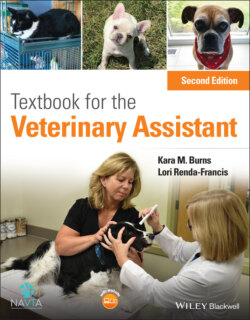Читать книгу Textbook for the Veterinary Assistant - Lori Renda-Francis - Страница 49
Animal body language Canine
ОглавлениеThe body language of animals is a good indicator of their emotional state. It is imperative that veterinary health‐care team members familiarize themselves with the body language of specific species and, when possible, a specific animal. Most dogs enjoy being with humans and exhibit behaviors that are associated with their happiness. This is indicated in dogs that initiate affection. Typically, these dogs wag their tail and approach people in a straightforward manner with a slightly lowered and/or cocked head. Although these dogs appear to be content, care must always be taken when the need to restrain arises. All dogs, even the happiest and most easy‐going, have the potential to bite if treated too roughly or if they are cornered and feel threatened.
The veterinary health‐care team must also become familiar with the body language of the fearful or anxious dog. The ears of a fearful dog are drawn down and back. These dogs make little to no eye contact and are typically cowering. There is a very high probability that they will bite if cornered or feeling threatened. Extreme caution must be exercised when trying to handle or restrain the dog exhibiting fearful or aggressive body language. The dog will exhibit aggressive body language by lowering its head to the level of the shoulders, giving a level and intense stare, positioning its tail out straight (sometimes with a slight wag), and growling or baring the teeth. Dogs exhibit fear or aggression through body posture. Dogs might show that they feel threatened by a human looking directly at their eyes or approaching them from the front.
Dominance aggression can be defined as aggression toward other members of the animal’s social group. This behavior is exhibited to prevent lower‐ranking members of the social group from performing actions or engaging in activities for which the higher‐ranking individual claims priority.
All dogs should be handled with the knowledge that they may bite at any time, and health‐care team members must be prepared for this. In dogs exhibiting fearful and aggressive body language, this is especially true.
The fight or flight principle is quite evident when talking of the behavior of canines. A dog’s typical defense mechanism will be to retreat (take flight) if it feels threatened. However, this is not true of all dogs, especially if the dog believes danger or threat is imminent. In this case, it may resort to the fight principle. We know that the canine dentition is designed for crushing and tearing and if a dog bites, that is the intent. Remember to observe the body language of the dog before restraining it. If the dog is baring its teeth, growling, curling its lips, and/or raising its hackles, the health‐care team must take precautions and control the muzzle of the dog or risk being bitten.
The health‐care team must also be prepared to control the dog’s legs and/or paws. Although a dog’s toenails are not generally thought of as dangerous, the dog may use them to attempt to ward off restraint. The dog’s thrashing of the legs and paws may cause serious scratches on members of the health‐care team, and these scratches have a high probability of becoming infected.
Appropriate steps must be taken by the health‐care team to insure the safety of the patient and the health‐care team. There are a variety of physical and pharmaceutical restraints that will aid in handling dogs to insure a safe hospital experience for the team and patient. It is important for the veterinary team to be familiar with physical restraint techniques. The veterinarian will diagnose and prescribe a pharmaceutical restraint when and if it is needed to insure the team’s and the patient’s safety.
The veterinary health‐care team should always record the behavior of a patient in the medical record. Aggressive behavior should be clearly marked in the patient’s record with a warning; this will help insure the safety of both the health‐care team and the patient. It is important to abide by the following when approaching a dog in the hospital.
Use the dog’s name.
Approach the dog quietly but confidently.
Lower yourself to the dog’s level but at a safe distance.
Slowly offer the back of your hand for the dog to smell.
Do not attempt to handle/restrain dogs in confined areas, as the dog may feel trapped.
